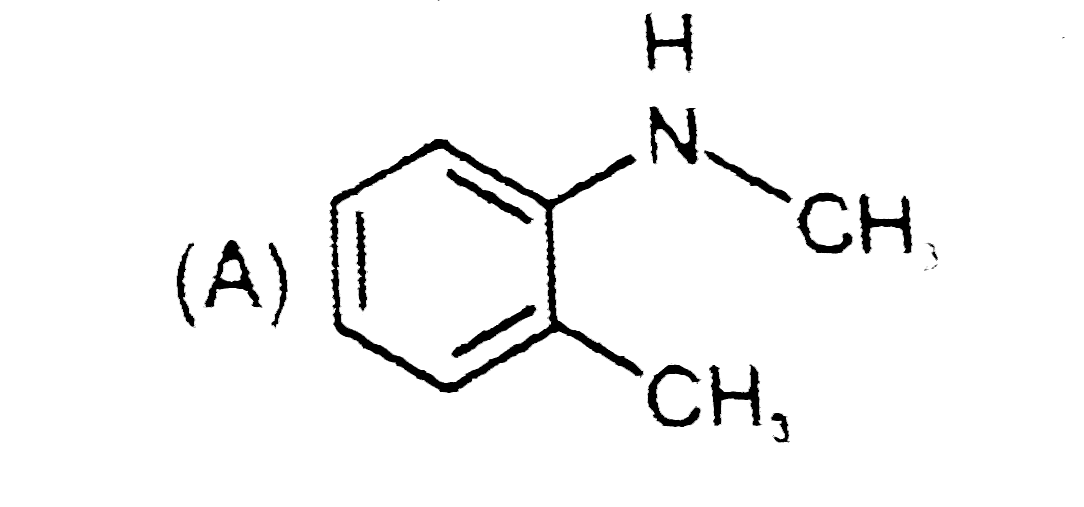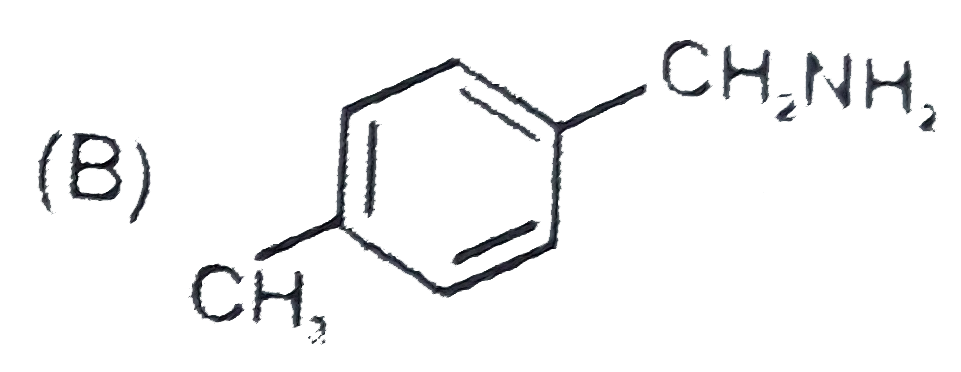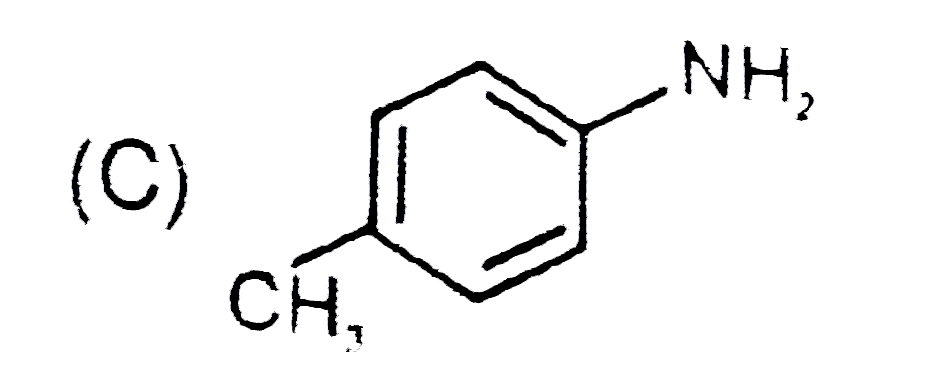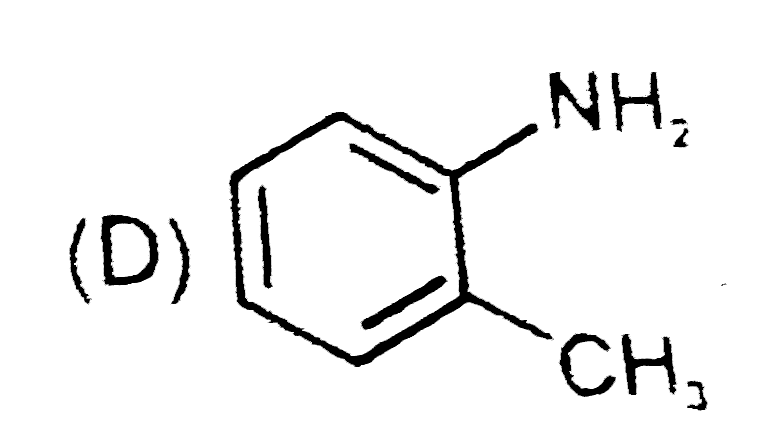An organic base (X) reacts with nitrous acid at 0∘ to give a clear solution. Heating with KCN and cuprous cyanide followed by continued heating with conc. HCl gives a crystaline solid. Heating this solid with alkaline potassium permangante gives a compound which dehydrates on heating to a crystaline solid. "X" is:




The correct Answer is:D
To solve the problem step by step, we need to analyze the reactions described and identify the organic base (X).
Step 1: Identify the reaction with nitrous acid
The organic base (X) reacts with nitrous acid (HNO2) at 0°C to form a clear solution. This indicates that X is likely an amine, as amines react with nitrous acid to form diazonium salts, which are soluble in water.
Hint: Consider that nitrous acid reacts with primary amines to form diazonium salts.
Step 2: Determine the structure of X
Given that the reaction produces a clear solution, we can deduce that X is likely a primary amine. Let's assume X is a simple primary amine, such as methylamine (CH3NH2).
Hint: Look for simple primary amines that can form diazonium salts.
Step 3: Reaction with KCN and cuprous cyanide
Next, the compound formed from the diazonium salt is heated with potassium cyanide (KCN) and cuprous cyanide (CuCN). This reaction typically leads to the formation of a substituted cyanide compound. For methylamine, the diazonium salt would react to form methyl cyanide (CH3CN).
Hint: Remember that the reaction with KCN and CuCN leads to the substitution of the diazonium group with a cyanide group.
Step 4: Heating with concentrated HCl
The next step involves heating the resulting cyanide compound with concentrated hydrochloric acid (HCl). This reaction would convert the cyanide group into a carboxylic acid, resulting in the formation of acetic acid (CH3COOH).
Hint: Consider how cyanides convert to carboxylic acids upon hydrolysis.
Step 5: Reaction with alkaline potassium permanganate
The carboxylic acid formed is then heated with alkaline potassium permanganate (KMnO4). This reagent is a strong oxidizing agent and can oxidize the carboxylic acid to a dicarboxylic acid, such as phthalic acid (C6H4(COOH)2).
Hint: Alkaline KMnO4 can oxidize alcohols and carboxylic acids to form dicarboxylic acids.
Step 6: Dehydration to form a crystalline solid
Finally, heating the dicarboxylic acid (phthalic acid) leads to dehydration, forming phthalic anhydride (C8H4O3), which is a crystalline solid.
Hint: Dicarboxylic acids can lose water to form anhydrides upon heating.
Conclusion
Based on the steps and the reactions described, the organic base (X) is methylamine (CH3NH2), which leads to the formation of phthalic anhydride after undergoing the series of reactions.
Final Answer: "X" is methylamine (CH3NH2).
The organic base (X) reacts with nitrous acid (HNO2) at 0°C to form a clear solution. This indicates that X is likely an amine, as amines react with nitrous acid to form diazonium salts, which are soluble in water.
Given that the reaction produces a clear solution, we can deduce that X is likely a primary amine. Let's assume X is a simple primary amine, such as methylamine (CH3NH2).
Next, the compound formed from the diazonium salt is heated with potassium cyanide (KCN) and cuprous cyanide (CuCN). This reaction typically leads to the formation of a substituted cyanide compound. For methylamine, the diazonium salt would react to form methyl cyanide (CH3CN).
The next step involves heating the resulting cyanide compound with concentrated hydrochloric acid (HCl). This reaction would convert the cyanide group into a carboxylic acid, resulting in the formation of acetic acid (CH3COOH).
The carboxylic acid formed is then heated with alkaline potassium permanganate (KMnO4). This reagent is a strong oxidizing agent and can oxidize the carboxylic acid to a dicarboxylic acid, such as phthalic acid (C6H4(COOH)2).
Finally, heating the dicarboxylic acid (phthalic acid) leads to dehydration, forming phthalic anhydride (C8H4O3), which is a crystalline solid.
Based on the steps and the reactions described, the organic base (X) is methylamine (CH3NH2), which leads to the formation of phthalic anhydride after undergoing the series of reactions.
Topper's Solved these Questions
- AROMATIC COMPOUNDS BOOK - RESONANCE ENGLISHCHAPTER - AROMATIC COMPOUNDS EXERCISE - PART-III: PRACTICE TEST-2(IIT-JEE(ADVANCED pattern))
7 Videos
- AROMATIC COMPOUNDS BOOK - RESONANCE ENGLISHCHAPTER - AROMATIC COMPOUNDS EXERCISE - Section -2 (one or more than one options correct type)
7 Videos
- AROMATIC COMPOUNDS BOOK - RESONANCE ENGLISHCHAPTER - AROMATIC COMPOUNDS EXERCISE - PART-I PRACTICE TEST-1(IIT-JEE MAIN PATTERN)
30 Videos
- ATOMIC STRUCTUREBOOK - RESONANCE ENGLISHCHAPTER - ATOMIC STRUCTUREEXERCISE - ORGANIC CHEMISTRY(Fundamental Concept )
16 Videos
Similar Questions
Knowledge Check
A white solid X reacts with dil. HCl to give colourless gas which is used in fire extinguishers. The solid X is
ANaClBCH3COONaCNa2CO3DNaHCO3
When boric acid reacts with sodium carbonate a white crystaline solid X is formed which on heating above 750 C gives
View SolutionWhich of the following compound gives paramagnetic gas on heating :-
View SolutionWhich of the following compound gives paramagnetic gas on heating :-
View SolutionQuartz on strong heating followed by rapid cooling gives glass which is an amorphous solid because
View SolutionDiborane reacts with ammonia to initially forms X which on further heating gives borazine X is
View SolutionWhich of the following compounds does give N2 on heating ?
View SolutionWhich of the following compounds does give N2 on heating ?
View Solution
